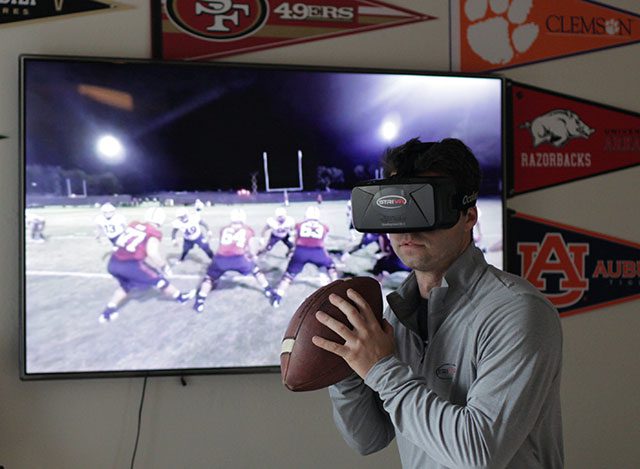When you are watching a professional football game, you may think you are witnessing a mighty display of physical and athletic skill. Well, you are only half right. Without the right strategy, intelligence, and competitive insight, all the muscle and speed in the world won’t help you win at the elite level.
That’s why after each game, the coaches and players immediately begin preparing for the next one. As the on-field leaders, it’s especially important for quarterbacks to completely understand the strategies, defensive play types, and strengths and weaknesses of the opposing team. Watching game tapes of the other team has been the time-tested way to get the insights that can make the difference between winning and losing.
For example, imagine that the coach calls in a running play that goes to the right. Seconds before the ball is hiked, the quarterback recognizes the movement of the linebackers and can tell that this play will end in a loss. The quarterback can change the play with an audible and use this knowledge to get a first down or much more.
This is basic knowledge for football coaches and fans.
What’s not as known is that using virtual reality to “live inside” the tapes has been shown to help quarterbacks dramatically improve the speed and recall of this strategic knowledge.
A company named STRIVR Labs has been helping over 20 colleges and NFL teams to use virtual reality practice and training to win championships.
It works so well that a recent study showed that STRIVR training led to a 20% reduction in reaction time when faced with a quick decision to make and a 12% increase in accurate answers. This is even more impressive when you consider that a quarterback can practice in VR without needing to suit up, go to the practice field, or even gather his teammates. Instead of dozens of snaps, a quarterback can do hundreds.
From the study:
“In our most recent research efforts we examined the ability for 711 individuals learning to ‘read’ a football play to determine whether a quarterback should (1) keep the ball and run or (2) pitch the ball to a running back (this is a very common decision point that arises in real games). Overall, our accuracy scores indicate that most users were able to successfully acquire the football concept in a relatively short amount of time. However, there was something a bit special about VR training. STRIVR-trained users were significantly faster at reading the play and making a decision: 3.01 seconds for STRIVR as compared to 3.77 seconds for regular video film. That is a 20% decrease in reaction time. In the world of a quarterback and even in any sport, this difference (0.76 seconds to be exact) can certainly be the difference between success and failure.
In addition to faster reaction time, more individuals learning with STRIVR successfully learned to read the defense; STRIVR users were correct 82% of the time, while those trained with regular video were correct only 76% of the time. Furthermore, given that individuals in both training groups answered the questions correctly, those trained with STRIVR in VR were 12% faster in getting the correct answer (2.37 seconds for those training in VR vs. 2.69 for those trained with 2D video). These results are very much in line with the correspondence we’ve observed with our quarterbacks over the past two years, with some quarterbacks going so far as to claim outright that STRIVR directly helped their performance.”
The next steps for virtual reality training will be to help learn motor skills like throwing, blocking, and catching. The millimeter accuracy of room-scale VR tracking with six degrees of freedom (6DoF) makes it possible to practice athletic skills and receive immediate, accurate feedback. Your virtual coach will see things that a human coach could never catch.
STRIVR has already moved in this direction by helping professional basketball players to improve their free throw percentage.
Visualization inside virtual reality brings a new weapon for sports training, as seen in this mind-blowing ball catching video by Disney Research:
The future of sports training will be done in virtual worlds. Old school video tapes and white boards will no longer cut it. We are excited to watch it unfold, and we’ll be here to keep you up to date.
But what if you are just an armchair quarterback with a regular day job? Well, STRIVR will help train you for that too:






